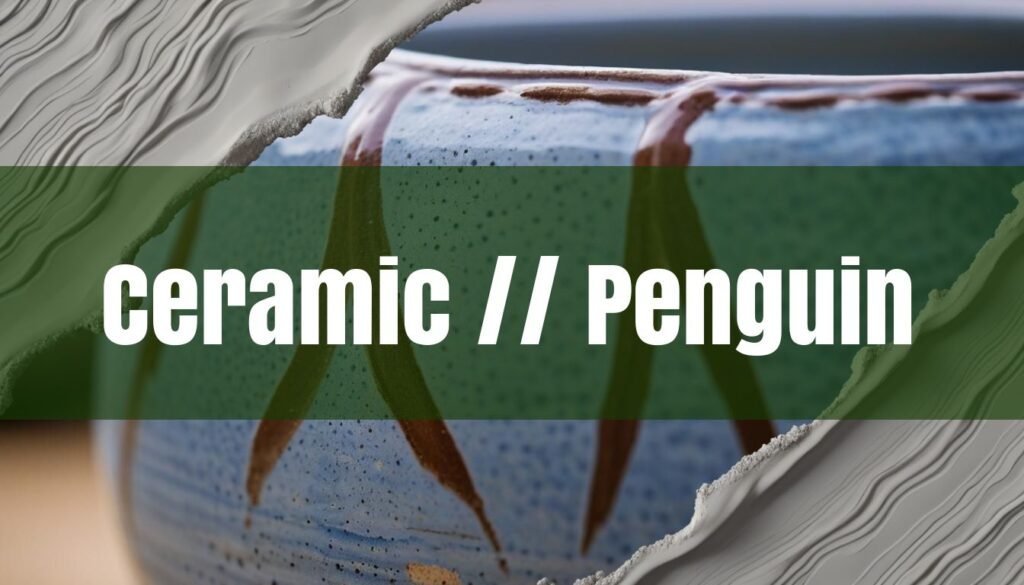Embarking on a ceramic penguin painting project is a delightful way to unleash your creativity. Whether you’re a seasoned artist or a beginner, the charm of transforming a plain ceramic figurine into a personalized masterpiece is undeniable. This article serves as your comprehensive guide to finding the perfect ceramic penguin to paint, exploring various purchasing options, offering advice on selecting the best figurine, and providing tips for achieving a stunning final result.
Finding Your Blank Canvas: Where to Buy Ceramic Penguins
The quest for the ideal ceramic penguin to paint begins with identifying reliable sources. Fortunately, a plethora of options are available, each with its own set of advantages. Online marketplaces such as Etsy and Amazon are treasure troves of unique, handcrafted, and commercially produced ceramic penguins. Etsy often features independent artists and small businesses, offering a diverse range of styles, sizes, and poses. You might discover a quirky, whimsical penguin or a more realistic, anatomically correct model. Amazon, on the other hand, typically provides a broader selection of mass-produced figurines, often at competitive prices.
For those who prefer a hands-on shopping experience, craft stores like Michael’s are excellent choices. These stores usually stock a variety of unpainted ceramic items, including penguins, especially during holiday seasons. The advantage of purchasing from a craft store is the ability to physically examine the figurine before buying, ensuring it meets your quality standards. Local pottery studios (search on maps) are another fantastic resource. Many studios offer “paint your own pottery” sessions or sell unfinished bisque figurines directly to customers. This option not only supports local artists but also provides the opportunity to seek advice and guidance from experienced ceramicists. When comparing these sources, consider factors such as price, penguin size and design variety, shipping costs (for online purchases), and the convenience of each option. You may also find inspiration in contemporary ceramic art. Consider also visiting pottery classes to further refine your painting skills. If you’re thinking about selling your art, check out how to sell pottery online. For insight into surface design, explore unlocking ceramic surface design.
Selecting the Perfect Penguin and Essential Supplies
Once you’ve identified potential sources, the next step is to choose a ceramic penguin that aligns with your artistic vision and skill level. Ceramic penguin figurines are available in various styles, sizes, and poses. Some are designed with smooth, simple surfaces, ideal for beginners or those who prefer clean, minimalist designs. Others feature intricate details and textures, offering a more challenging and rewarding painting experience for advanced artists. Consider the size of the figurine as well. A larger penguin provides a bigger canvas for elaborate designs, while a smaller one is perfect for quick, simple projects or for creating a collection of miniature penguins.
Before you start painting, gather the necessary supplies. The ideal paint types for ceramic figurines include acrylics, enamels, and porcelain paints. Acrylic paints are versatile, affordable, and dry quickly, making them a popular choice for both glazed and unglazed pottery (painting ceramics). Enamel paints are oil-based and offer excellent durability and a glossy finish, particularly suitable for glazed ceramics (painting ceramics). Porcelain paints are specifically designed for ceramics and can be baked in a conventional oven to create a waterproof and washable finish (porcelain paints). In addition to paints, you’ll need a selection of brushes in various sizes, a palette for mixing colors, water for cleaning brushes, and a sealant to protect your finished masterpiece.
Preparing and Painting Your Penguin
Proper preparation is key to achieving a professional-looking result. Start by cleaning the ceramic surface with a damp cloth to remove any dust or dirt (cleaning the ceramic surface). If the figurine has a glossy surface, lightly sand it with fine-grit sandpaper to create better adhesion for the paint (sanding it). Apply a coat of primer to further enhance paint adhesion and prevent the ceramic from absorbing too much paint (applying a coat of primer).
Now comes the fun part: painting! Let your imagination run wild and experiment with different design ideas and techniques. For a realistic penguin, study photographs of real penguins and try to replicate their natural colors and markings. For a whimsical penguin, use bright, bold colors and add fun patterns and details. Consider painting the face and belly white, the nose and feet orange, and the rest black (painting the penguin). Get creative with the eyes, using fun writers to add sparkle and personality. Apply multiple coats of paint for full coverage, allowing each coat to dry completely before applying the next. Once you’re satisfied with your design, apply a sealant to protect the paint and give your penguin a glossy finish (apply a sealant).





